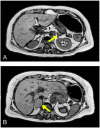"Never Trust to General Impressions, My Boy, but Concentrate Yourself upon Details": An Unusual and Challenging Presentation of Pheochromocytoma
- PMID: 34203668
- PMCID: PMC8232323
- DOI: 10.3390/jcdd8060071
"Never Trust to General Impressions, My Boy, but Concentrate Yourself upon Details": An Unusual and Challenging Presentation of Pheochromocytoma
Abstract
We present the case of a 45-year-old woman admitted to our unit with acute heart failure and cardiogenic shock, requiring an intra-aortic balloon pump insertion and inotropes and vasopressors infusion. Despite such treatment, the patient developed multi organ failure and intravascular disseminated coagulation with haemolysis. The initial diagnosis of acute myocarditis was subsequently denied by the finding of bilateral adrenal masses by MRI scan, and urine and plasma metanephrines measurements confirmed a pheochromocytoma (PCC). Genetic analysis revealed a mutation in the neurofibromatosis type 1 (NF1) gene, and an accurate physical examination drew attention to small cafè-au-lait spots, usually associated with this syndrome. PCC diagnosis should be promptly considered in patients presenting with unexplained acute heart failure and cardiogenic shock of unknown origin, considering its life-threatening complications and the good prognosis after radical surgery.
Keywords: acute cardiogenic shock; acute myocarditis; pheochromocytoma.
Conflict of interest statement
The authors report no relationships that could be construed as a conflict of interest.
Figures
References
-
- Di Palma G., Daniele G.P., Antonini-Canterin F., Piazza R., Nicolosi G.L. Cardiogenic Shock with Basal Transient Left Ventricular Ballooning (Takotsubo-Like Cardiomyopathy) sa First Presentation of Pheochromocytoma. J. Cardiovasc. Med. 2010;11:507–510. doi: 10.2459/JCM.0b013e32832b4ccc. - DOI - PubMed
-
- Lopes A., Sousa C., Correia M.J., Junior C., Rocha J., Pinto F. Cardiomyopathy: First Clinical Manifestation of a Pheochromocytoma—Case Report. Rev. Port. Cardiol. 2010;29:1065–1069. - PubMed
Publication types
LinkOut - more resources
Full Text Sources
Research Materials
Miscellaneous



